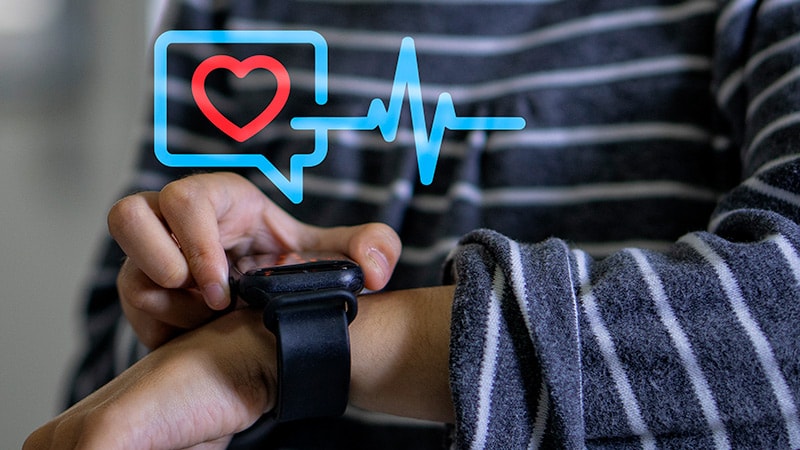In recent years, smartwatches have gained popularity across Europe, driven by an increase in health awareness, smartphone integration, and advancements in wearable technology. They are now able to monitor an increasing number of health metrics, including the now-popular heart rate variability (HRV).
So what happens when a patient comes to the clinic worried about their HRV status, as reported by their watch?
To learn more about HRV and its clinical significance, Medscape Medical News spoke with two experts.
Professor Thomas Gronwald, PhD, is head of the Department of Performance, Neuroscience, Therapy and Health at MSH Medical School Hamburg, Germany. He is an exercise and training scientist with a focus on internal and external load analysis in strength and conditioning training.
Cailbhe Doherty, PhD, is an assistant professor at the School of Public Health, Physiotherapy, and Sports Science at University College Dublin, Ireland. His research is dedicated to investigating the effectiveness of consumer wearables in public health and the integration of mobile technologies in healthcare systems.
What is HRV? And is it possible for smartwatches/wearables to accurately measure it?  Thomas Gronwald, PhD
Thomas Gronwald, PhD
Doherty: HRV is the variation in time between successive heartbeats. So even if your heart is beating at 60 beats/min, that doesn’t mean it’s beating exactly once every second. There are tiny fluctuations between beats — sometimes 0.98 seconds, sometimes 1.02 — and that variation is what we call HRV. Those fluctuations aren’t random. They’re governed by your autonomic nervous system…and within that system, there’s a kind of balance: the sympathetic branch, which speeds things up (fight or flight), and the parasympathetic branch, which slows things down (rest and digest). HRV reflects that balance. In simple terms, a higher HRV generally indicates a more adaptable, resilient nervous system, and it’s often used as a proxy for recovery, stress, and overall cardiovascular health.
Gronwald: The gold standard for a valid and reliable assessment of the time between two successive heartbeats is the electrocardiogram (ECG), which allows recordings in the laboratory or during daily activity — up to 24 hours or longer. Several mobile and user-friendly measurement systems and wearables exist, which can record R-R intervals with different applications and form factors — chest strap systems, adhesive patches, and electrode systems on the skin — that utilize not only electrophysiologic but also optically derived signals such as photoplethysmography…. Most commercially available portable devices show a low absolute error under resting conditions but should always be validated against reference measures to clarify the accuracy of data parameters and maximize real-world application value.
Is HRV an important measure of someone’s health? Is it an important measure for an athlete?
Doherty: Yes, but with some important qualifications. HRV can be a valuable indicator of health, but it’s not a silver bullet. In a general health context, higher HRV is often associated with better cardiovascular health, lower levels of chronic stress, and even reduced risk for mortality…. It’s a useful window into your overall resilience. The issue is that HRV is highly individual. What’s high for one person might be low for another. It’s not the kind of measure where a single value tells the whole story. You really need to look at trends over time and ideally interpret them in the context of things like sleep, recovery, illness, and training load.
Gronwald: The usefulness of HRV as an indicator of physiologic and pathologic conditions, for risk stratification, and as a marker of autonomic adaptive and regulatory capacity is evident. However, longitudinal data recordings are recommended when trend analysis with contextual data is intended. Considering the mentioned context-sensitive requirements, HRV analysis allows for longitudinal trend analysis of patients and healthy individuals, including athletic and nonathletic populations in various clinical and performance-related settings. This includes the application of HRV monitoring for resting conditions, during and/or after biofeedback and training interventions, as well as general relationships between recovery status, previous exercise conditions, and symptoms of overreaching and overtraining.
What should a doctor do if someone goes to them saying their smartwatch is showing that they continuously have a low HRV status?  Cailbhe Doherty, PhD
Cailbhe Doherty, PhD
Doherty: I’d suggest it should be treated as a starting point. The physician might ask: Has this person noticed other symptoms — fatigue, poor sleep, high stress? Has their resting heart rate changed? Are there lifestyle factors — alcohol, illness, overtraining, or mental health — that could explain the trend? And if it seems warranted, they could conduct more standardized assessments, such as an ECG-based HRV measurement or a broader autonomic function test. The data is not medical grade and we don’t know enough about how the proprietary algorithms are processing the signals. But if the question is whether the HRV trend might reflect something real, then yes, it’s possible. Ultimately, I think wearables are better at raising questions than answering them. And that’s not a bad thing.
Is such data reliable?
Gronwald: This depends strongly on the wearable or recording device. The measurement principles and the type of analysis and processing of the biosignal vary significantly between different devices. On the one hand, sleep analyses are used during the night, while on the other hand, context-free time points during the day are often used. Here, care should be taken to include standardized situations for a measurement and interpretation context. It is recommended to use validated measurement systems that either use the entire night as a reference phase or a consistent measurement situation early in the morning after waking up without prior stressors. Both approaches have advantages and disadvantages.
How can someone improve their HRV?
Gronwald: HRV improves when the body is balanced between activity and recovery within hemodynamic boundaries, with strong support from sleep, stress reduction, and a healthy active lifestyle. Regular physical activity, especially moderate aerobic exercise — such as walking, cycling, or swimming — and strength training can increase HRV over time. Breathing exercises with slow, deep, and diaphragmatic breathing — for example 4-6 breaths per minute — can help to activate the parasympathetic nervous system, which improves HRV. Good sleep quality with consistent sleep patterns, enough deep sleep, and avoiding late-night screen time and activity are essential for higher HRV. Further, stress management and practices such as meditation, social connection, mindfulness, or progressive muscle relaxation are linked to emotional well-being and can reduce stress and therefore improve HRV. Finally, healthy nutrition habits such as a balanced diet rich in whole foods, omega-3 fatty acids, fruits, and vegetables supports HRV — including limitation of stimulants, alcohol, nicotine, and processed foods.
How important do you think wearable technology is to support the provision of healthcare across Europe? What role do you think it will play in the future?
Doherty: Healthcare systems across Europe are facing enormous pressure: aging populations, rising chronic disease, long waiting lists, and constrained resources. Wearables offer something really compelling in that context: the ability to monitor people continuously, passively, and remotely, outside the clinic, in real-world settings. [But] at the moment, most wearable data isn’t integrated into the healthcare system. It lives in consumer ecosystems — Apple, Google, Fitbit, Garmin — and that creates problems around standardization, privacy, and clinical utility. We can’t expect a GP or a cardiologist to wade through raw data from 10 different apps and figure out what it means.
There are also big equity issues. Most wearables are still designed and validated in relatively narrow populations — usually younger, healthier, often White, middle-income users. If we start using wearable data in clinical decision-making, we need to be absolutely sure it’s valid across diverse populations, otherwise we risk baking health inequalities into digital health systems.
Another issue is data privacy. When we start linking consumer data to clinical records, the stakes get much higher. Who owns the data? Who profits from it? Who gets access to it? Ultimately, I think wearables will play an increasingly important role in population health monitoring, early detection, and personalized prevention. But for that to happen in a way that is safe, effective, and fair, we need interoperability, regulatory oversight — especially on algorithm transparency, robust validation in real-world populations, and a clear framework around data rights and governance.
Gronwald and Doherty reported no relevant financial relationships.
Sophie Cousins, MIPH, is a global health journalist who has reported from more than 20 countries.
